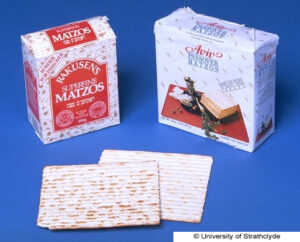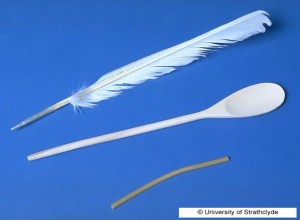Passover begins on the 14th day of the Jewish month of Nisan (March 29, 2010). The primary observances of Passover are related to the Exodus from Egypt after generations of slavery. The command to observe Passover continuously is found in Exodus 12:14.
Now this day will be a memorial to you, and you shall celebrate it as a feast to the Lord; throughout your generations you are to celebrate it as a permanent ordinance.
In the first Passover, God commanded each Hebrew household in Egypt to sacrifice a perfect yearling lamb and sprinkle the blood on the lintels and the doorposts. The “Angel of Death” then passed over the houses which were protected by the blood of the lamb, but where there was no blood, the first born was slain. This account is found in Exodus 11.
Modern Passover observances include the removal of chametz (leaven) from the homes. This commemorates the fact that the Jews leaving Egypt did not have time to let their bread rise. Leaven is also a biblical symbol for sin. Consequently, Matzo or unleavened bread is eaten during the feast.
Another significant element in the Passover observance are the five cups of wine. Each cup recalls one of the five statements of deliverance found in the Passover account (Ex. 6:6-8). 1) “I will bring you out …” 2) “I will rid you of all their bondage.” 3) “I will redeem you …” 4) “I will take you to me for a people, …” 5) “I will bring you into the Land …” Consequently, four toasts are offered to God thanking Him for His deliverance. The four toasts are all named: 1) the Cup of Thanksgiving 2) the Cup of Plagues 3) the Cup of Redemption 4) the Cup of Praise. Offering the fifth cup awaits the appearance of Elijah the Prophet to precede the coming of the Messiah.
Messianic Significance
The traditional Jewish Passover observance is highly significant for those who believe in the Messiahship of Yeshua (Jesus). Yeshua observed the traditional order of the Passover (the Seder) during the meal commonly known as the Last Supper (Matt. 26:17-29). The Last Supper was a traditional, orthodox Passover Seder. The person and work of Yeshua are portrayed throughout the Seder in symbolic form. The most significant ceremony found in the Seder is origin of the ordinance of Communion.
During the Last Supper, His last Passover Seder, Yeshua exercised Messianic authority by transforming a ceremony that was culture bound to Israel and turning it into a ceremony that, today, is celebrated by Believers from every tongue and tribe and people and nation. During the Passover Seder He came to the third toast of thanksgiving offered to God. The third cup is associated with the third “I will” statement found in the Exodus story; “I will redeem you with an outstretched arm and great judgments.” Traditionally, the Third Cup is raised to thank God for physical redemption from slavery in Egypt. Instead, Yeshua transforms the Third Cup into a symbol of spiritual redemption from slavery to sin. He associates the cup with the New Covenant of Jeremiah 31:31-34. The essence of the New Covenant is spiritual redemption from sin. His actions and words are recorded in Luke 22:20, “And in the same way He took the cup after they had eaten, saying, ‘This cup which is poured out for you is the new covenant in My blood.’” The Cup of the Redemption now becomes the Cup of Communion we all enjoy today.
In like manner He transformed the symbolism of the Unleavened Bread (Matzo). During the Seder He specifically identified the Matzo with His body. The Matzo is an adequate symbol of the body of the Messiah for five reasons. 1) It is made without leaven which is a symbol of sin. Likewise, Yeshua was sinless. 2) It is made without salt. A rich man could afford to flavor his matzo with salt but a poor man could not. In the same manner, Yeshua was a poor carpenter. 3) The matzo is striped from hot, swift baking. Likewise, His body was striped by means of the Roman whip. 4) The matzo is pierced to prevent rising. Similarly, His body was pierced by the Roman nails in His hands and feet and the Roman spear thrust in his side. 5) Finally, during the Seder the matzo is broken. This action dramatizes His death on the cross when His soul was torn away from his body. Yeshua exercised Messianic authority by transforming a ceremony that is culture bound to Israel and turning it into an ordinance all Believers can embrace. Believers from every family, tribe, tongue, and nation celebrate the eating of the matzo today.
Observing the origin of the ordinance of Communion and contemplating its meaning is surely a good reason for Believers today to celebrate the Festival of Passover.
Search for the Leaven (Hmetz)
One of the most significant ceremonies of the Passover (Pesach) is the search for and removal of every speck of leaven from the Jewish home. The ceremony is significant for three reasons. 1) In the account of the Exodus, the Jewish people leave Egypt in haste. We are unable to take the time to allow our bread to rise. As a result, unleavened bread (Matzo) is a symbol of our hurried departure (Ex. 12:34). 2) Bread made without leaven is associated with the slavery in Egypt. In Deuteronomy 16:3, the Matzo is called the “Bread of Affliction.” It is a reminder of the affliction of slavery. 3) Finally, leaven is a symbol of sin. Leaven causes fermentation which is a form of decay. Therefore, anything leavened was considered impure because it had gone hametz or sour. Consequently, in the rabbinic mind, leaven became a symbol of sin. For example, the Talmud says, “leaven represents the evil impulse of the heart” (Berachot 17a). It is a symbol of the puffiness (arrogance, pride) in our hearts.
Every speck of leaven is arduously removed from the Jewish home before Passover. God did not even want the symbol of sin to be present in the Jewish home for this festival. The morning before the Seder, the cleaning is completed and a diligent search made for any stray leaven using a feather and wooden spoon (photo right). A small portion of leaven is usually left behind by the mother so that it can be found and disposed of. The leaven is swept onto the spoon by the feather, wrapped in a cloth, taken outside and burned. The father then declares his house clean and prepared for Passover.
Cup of Elijah
According to the Bible, Elijah, one of the great Jewish prophets, never died but was carried off to heaven in a fiery chariot. Tradition identifies Elijah as the forerunner of the Messiah. Tradition states the Elijah will return from heaven on the night of Passover to precede the coming of the Messiah (Malachi 4:5). In the course of the Seder meal, a seat is provided at the table for the prophet. A cup of wine is poured for Elijah and the front door is opened as a symbolic gesture of welcoming the prophet.
Matzah

www.strath.ac.uk
Matzah is the Hebrew word for unleavened bread (plural – Matzot). It is a thin wafer-like bread, which is made from a mixture of flour and water. Because it does not contain yeast, it can be baked quickly. According to the Jewish scriptures, the Hebrews took matzah with them when they fled from Egypt because they did not have time to wait for the bread to rise. To commemorate this, matzah is eaten on the first night of Passover. There are three matzot on the Seder table. They are placed in a central position near the Seder plate. The ceremony known as the “breaking of the middle matzah” contains great spiritual significance that is hidden from the Jewish community today due to our rejection of the Messiahship of Yeshua.
The Breaking of the Middle Matzo

www.jesusboat.com
The three sheets of Unleavened Bread are placed in a Matzotash (Matzo Cover, pictured left). The Matzotash is a decorative bag made up of three pockets. Each pocket contains one sheet of Unleavened Bread. The traditional ceremony follows this pattern: the Middle Matzo is withdrawn from the Matzotash, displayed to all at the table, broken, wrapped in a linen napkin, hidden away during the meal, recovered, unwrapped, and a piece eaten by everyone at the table.
The Matzotash symbolizes our triune God. The top Matzo stands for God the Father, the middle Matzo for God the Son, and the bottom Matzo for God the Spirit. The withdrawing of the Middle Matzo portrays the incarnation of the Son of God when He came into our world as a man. Displaying the Matzo depicts the Messiah’s 3½-year public ministry to Israel. The Matzo is broken signifying His death on the Cross. The wrapped piece of Matzo dramatizes the fact that the body of the Messiah was wrapped in linen grave clothes. Hiding the Matzo signifies that the body of the Messiah was hidden away in the grave for three days and three nights. Recovering and unwrapping the hidden Matzo dramatizes the Messiah’s resurrection. Finally, each guest eating a piece of the Matzo at the Seder signifies the communion we all have with our risen Lord and Savior. The Breaking of the Middle Matzo is a very significant ceremony indeed (Matt. 26:26)!
Passover Seder Plate

www.strath.ac.uk
The most prominent symbol on the Passover table is the Passover Seder Plate. Passover Seder plates come in all kinds of sizes and designs; however, there is one element common to every Seder plate. That element is the six indicators that show where the six symbols of the Passover are placed.
The most prominent symbol on the Seder plate is the Shankbone of a Lamb. The shankbone recalls the Passover sacrifice called the “Pesach.” The Pesach was the year-old, unblemished lamb that was offered by the family and became the main course for the Passover banquet during the Seder.
Another symbol of sacrifice on the Seder Plate is the Hardboiled Egg. The egg recalls the Passover Peace Offering called the Chagiah. In addition, it is a symbol of mourning recalling the destruction of the Temple in Jerusalem during 70 AD by the Romans. When the egg is a symbol of mourning it is dipped in salt water representing salty tears.
A symbol of slavery found on the plate is the Bitter Herbs. When the bitter herb is eaten, it brings tears to the eyes and recalls the bitter tears of Egyptian slavery.
Another symbol of slavery is the fruit paste called Charoset. The brown Charoset looks just like the brick making material we had to toil over as slaves to Pharaoh, so it is a symbol of slavery. However, Charoset tastes delicious teaching us that God’s kindness made slavery bearable.
Carpas is the green vegetable found on the Seder plate. Green is a symbol of springtime and youthfulness. The Carpas is dipped in salt water. The salt water stands for the salt water of the Red Sea. Dipping the Carpas means that, in the springtime of our nationhood, God saved us and redeemed us by bringing us through the salt water of the Red Sea.
Usually, the final item on the Passover plate is the Salt Water. It stands for the salt water of the Red Sea or salty tears depending on how the symbol is being used.



